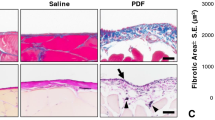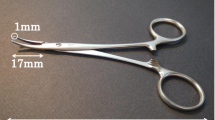Abstract
Background
Peritoneal injury is an important cause of technical failure of long-term peritoneal dialysis (PD). Encapsulating peritoneal sclerosis (EPS) is a severe complication of long-term PD with potentially life threatening consequences. CD147 is a glycoprotein with diverse functions including modulation of extracellular matrix via induction of matrix metalloproteinases, cell adhesion, and regulation of immune reactions. We hypothesized that CD 147 plays a role in the peritoneal cavity.
Methods
In this retrospective study, we localized CD147 by immunohistochemistry in peritoneal biopsies from uremic patients not on PD (n = 8), on PD without signs of EPS (n = 7), and in biopsies in patients with the diagnosis of EPS (n = 7). Double immunofluorescence was used to co-localize α-smooth-muscle actin (α-SMA) and CD147 in selected biopsies from each group. Expression was scored semi-quantitatively.
Results
In biopsies from uremic controls, CD147 was prominently expressed in mesothelial cells, focally between fat cells and by some perivascular cells. In patients on PD, a similar distribution was present (although mesothelium was rarely conserved), with some focal accentuation. In EPS, layers of fibroblastic cells were positive for CD147. EPS biopsies demonstrated a significantly higher score in a blinded evaluation, compared to uremic patients. Cells expressing CD147 were α-SMA positive myofibroblasts as demonstrated by double immunofluorescence. Mean CD147 scores did not differ between patients with different transporter status.
Conclusions
This is the first study demonstrating CD147 on a major part of fibroblastic cells in EPS. Future studies need to address the role of these cells in this severe complication of long-term PD.




Similar content being viewed by others
References
Kaneko K, Hamada C, Tomino Y. Peritoneal fibrosis intervention. Perit Dial Int. 2007;27(Suppl 2):S82–6.
Zhou Q, Bajo MA, Del Peso G, Yu X, Selgas R. Preventing peritoneal membrane fibrosis in peritoneal dialysis patients. Kidney Int. 2016. doi:10.1016/j.kint.2016.03.040.
Devuyst O, Margetts PJ, Topley N. The pathophysiology of the peritoneal membrane. J Am Soc Nephrol. 2010;21(7):1077–85. doi:10.1681/ASN.2009070694 ([pii]: ASN.2009070694).
Krediet RT, Struijk DG. Peritoneal changes in patients on long-term peritoneal dialysis. Nat Rev Nephrol. 2013;9(7):419–29. doi:10.1038/nrneph.2013.99.
Kawanishi H. Surgical and medical treatments of encapsulation peritoneal sclerosis. Contrib Nephrol. 2012;177:38–47. doi:10.1159/000336934.
Miyazaki M, Yuzawa Y. The role of peritoneal fibrosis in encapsulating peritoneal sclerosis. Perit Dial Int. 2005;25(Suppl 4):S48–56.
Latus J, Ulmer C, Fritz P, Rettenmaier B, Biegger D, Lang T, et al. Encapsulating peritoneal sclerosis: a rare, serious but potentially curable complication of peritoneal dialysis-experience of a referral centre in Germany. Nephrol Dial Transpl. 2013;28(4):1021–30. doi:10.1093/ndt/gfs159.
Pletinck A, Vanholder R, Veys N, Van Biesen W. Protecting the peritoneal membrane: factors beyond peritoneal dialysis solutions. Nature Rev Nephrol. 2012;8(9):542–50. doi:10.1038/nrneph.2012.144.
Hahn JN, Kaushik DK, Yong VW. The role of EMMPRIN in T cell biology and immunological diseases. J Leukoc Biol. 2015;98(1):33–48. doi:10.1189/jlb.3RU0215-045R.
Kosugi T, Maeda K, Sato W, Maruyama S, Kadomatsu K. CD147 (EMMPRIN/Basigin) in kidney diseases: from an inflammation and immune system viewpoint. Nephrol Dial Transpl. 2015;30(7):1097–103. doi:10.1093/ndt/gfu302.
Liao CG, Kong LM, Song F, Xing JL, Wang LX, Sun ZJ, et al. Characterization of basigin isoforms and the inhibitory function of basigin-3 in human hepatocellular carcinoma proliferation and invasion. Mol Cell Biol. 2011;31(13):2591–604. doi:10.1128/MCB.05160-11.
Braun N, Alscher DM, Fritz P, Edenhofer I, Kimmel M, Gaspert A, et al. Podoplanin-positive cells are a hallmark of encapsulating peritoneal sclerosis. Nephrol Dial Transpl. 2011;26(3):1033–41. doi:10.1093/ndt/gfq488 ([pii]: gfq488).
Braun N, Alscher MD, Fritz P, Latus J, Edenhofer I, Reimold F, et al. The spectrum of podoplanin expression in encapsulating peritoneal sclerosis. PloS One. 2012;7(12):e53382. doi:10.1371/journal.pone.0053382.
Nakamoto H. Encapsulating peritoneal sclerosis–a clinician’s approach to diagnosis and medical treatment. Perit Dial Int. 2005;25(Suppl 4):S30–8.
Vlijm A, Stoker J, Bipat S, Spijkerboer AM, Phoa SS, Maes R, et al. Computed tomographic findings characteristic for encapsulating peritoneal sclerosis: a case-control study. Perit Dial Int. 2009;29(5):517–22.
Honda K, Nitta K, Horita S, Tsukada M, Itabashi M, Nihei H, et al. Histologic criteria for diagnosing encapsulating peritoneal sclerosis in continuous ambulatory peritoneal dialysis patients. Adv Perit Dial. 2003;19:169–75.
Braun N, Sen K, Alscher MD, Fritz P, Kimmel M, Morelle J, et al. Periostin: a matricellular protein involved in peritoneal injury during peritoneal dialysis. Perit Dial Int. 2013. doi:10.3747/pdi.2010.00259.
Heller F, Lindenmeyer MT, Cohen CD, Brandt U, Draganovici D, Fischereder M et al. The contribution of B cells to renal interstitial inflammation. Am J Pathol. 2007;170(2):457–68. doi:10.2353/ajpath.2007.060554 ([pii]: S0002-9440(10)60869-3).
Muramatsu T. Basigin (CD147), a multifunctional transmembrane glycoprotein with various binding partners. J Biochem. 2015. doi:10.1093/jb/mvv127.
Pinheiro C, Longatto-Filho A, Soares TR, Pereira H, Bedrossian C, Michael C, et al. CD147 immunohistochemistry discriminates between reactive mesothelial cells and malignant mesothelioma. Diagn Cytopathol. 2012;40(6):478–83. doi:10.1002/dc.22821.
Ross JA, Ansell I, Hjelle JT, Anderson JD, Miller-Hjelle MA, Dobbie JW. Phenotypic mapping of human mesothelial cells. Adv Perit Dial. 1998;14:25–30.
Geyer SJ. CD147 immunohistochemistry discriminates between reactive mesothelial cells and malignant mesothelioma: an expanded analysis of the data. Diagn Cytopathol. 2014;42(8):734. doi:10.1002/dc.22985.
Seeger H, Braun N, Latus J, Alscher MD, Fritz P, Edenhofer I, et al. Platelet-derived growth factor receptor-beta expression in human peritoneum. Nephron Clin Pract. 2014;128(1–2):178–84. doi:10.1159/000368241.
Latus J, Habib SM, Kitterer D, Korte MR, Ulmer C, Fritz P, et al. Histological and clinical findings in patients with post-transplantation and classical encapsulating peritoneal sclerosis: a European multicenter study. PloS one. 2014;9(8):e106511. doi:10.1371/journal.pone.0106511.
Braun N, Fritz P, Ulmer C, Latus J, Kimmel M, Biegger D, et al. Histological criteria for encapsulating peritoneal sclerosis - a standardized approach. PloS one. 2012;7(11):e48647. doi:10.1371/journal.pone.0048647.
Braun N, Alscher DM, Fritz P, Edenhofer I, Kimmel M, Gaspert A, et al. Podoplanin-positive cells are a hallmark of encapsulating peritoneal sclerosis. Nephrol Dial Transpl. 2011;26(3):1033–41. doi:10.1093/ndt/gfq488.
Grass GD, Dai L, Qin Z, Parsons C, Toole BP. CD147: regulator of hyaluronan signaling in invasiveness and chemoresistance. Adv Cancer Res. 2014;123:351–73. doi:10.1016/b978-0-12-800092-2.00013-7.
Biswas C, Zhang Y, DeCastro R, Guo H, Nakamura T, Kataoka H, et al. The human tumor cell-derived collagenase stimulatory factor (renamed EMMPRIN) is a member of the immunoglobulin superfamily. Cancer Res. 1995;55(2):434–9.
Tang J, Guo YS, Zhang Y, Yu XL, Li L, Huang W, et al. CD147 induces UPR to inhibit apoptosis and chemosensitivity by increasing the transcription of Bip in hepatocellular carcinoma. Cell Death Differ. 2012;19(11):1779–90. doi:10.1038/cdd.2012.60.
Rosenthal EL, Zhang W, Talbert M, Raisch KP, Peters GE. Extracellular matrix metalloprotease inducer-expressing head and neck squamous cell carcinoma cells promote fibroblast-mediated type I collagen degradation in vitro. Mol Cancer Res MCR. 2005;3(4):195–202. doi:10.1158/1541-7786.mcr-04-0203.
Karsdal MA, Larsen L, Engsig MT, Lou H, Ferreras M, Lochter A, et al. Matrix metalloproteinase-dependent activation of latent transforming growth factor-beta controls the conversion of osteoblasts into osteocytes by blocking osteoblast apoptosis. J Biol Chem. 2002;277(46):44061–7. doi:10.1074/jbc.M207205200.
Kato N, Kosugi T, Sato W, Ishimoto T, Kojima H, Sato Y, et al. Basigin/CD147 promotes renal fibrosis after unilateral ureteral obstruction. Am J Pathol. 2011;178(2):572–9. doi:10.1016/j.ajpath.2010.10.009.
Yurchenko V, Constant S, Eisenmesser E, Bukrinsky M. Cyclophilin-CD147 interactions: a new target for anti-inflammatory therapeutics. Clin Exp Immunol. 2010;160(3):305–17. doi:10.1111/j.1365-2249.2010.04115.x.
Seizer P, May AE. Platelets and matrix metalloproteinases. Thromb Haemost. 2013;110(5):903–9. doi:10.1160/TH13-02-0113.
Kato N, Yuzawa Y, Kosugi T, Hobo A, Sato W, Miwa Y, et al. The E-selectin ligand basigin/CD147 is responsible for neutrophil recruitment in renal ischemia/reperfusion. J Am Soc Nephrol. 2009;20(7):1565–76. doi:10.1681/asn.2008090957.
Schroppel B, Fischereder M, Wiese P, Segerer S, Huber S, Kretzler M, et al. Expression of glucose transporters in human peritoneal mesothelial cells. Kidney Int. 1998;53(5):1278–87.
Muramatsu T. Basigin (CD147), a multifunctional transmembrane glycoprotein with various binding partners. J Biochem. 2016;159(5):481–90. doi:10.1093/jb/mvv127.
Garosi G, Di Paolo N. Morphological aspects of peritoneal sclerosis. J Nephrol. 2001;14(Suppl 4):S30–8.
Goodlad C, Tarzi R, Gedroyc W, Lim A, Moser S, Brown EA. Screening for encapsulating peritoneal sclerosis in patients on peritoneal dialysis: role of CT scanning. Nephrol Dial Transpl. 2011;26(4):1374–9. doi:10.1093/ndt/gfq533.
De Vriese AS, Tilton RG, Stephan CC, Lameire NH. Vascular endothelial growth factor is essential for hyperglycemia-induced structural and functional alterations of the peritoneal membrane. J Am Soc Nephrol. 2001;12(8):1734–41.
Aroeira LS, Aguilera A, Selgas R, Ramirez-Huesca M, Perez-Lozano ML, Cirugeda A, et al. Mesenchymal conversion of mesothelial cells as a mechanism responsible for high solute transport rate in peritoneal dialysis: role of vascular endothelial growth factor. Am J Kidney Dis. 2005;46(5):938–48. doi:10.1053/j.ajkd.2005.08.011.
Tang Y, Nakada MT, Kesavan P, McCabe F, Millar H, Rafferty P, et al. Extracellular matrix metalloproteinase inducer stimulates tumor angiogenesis by elevating vascular endothelial cell growth factor and matrix metalloproteinases. Cancer Res. 2005;65(8):3193–9. doi:10.1158/0008-5472.can-04-3605.
Bougatef F, Quemener C, Kellouche S, Naimi B, Podgorniak MP, Millot G, et al. EMMPRIN promotes angiogenesis through hypoxia-inducible factor-2alpha-mediated regulation of soluble VEGF isoforms and their receptor VEGFR-2. Blood. 2009;114(27):5547–56. doi:10.1182/blood-2009-04-217380.
Acknowledgements
St. S. is supported by a Grant by Fundação Pesquisa e Desenvolvimento Humanitario; and the Else-Kröner Fresenius Stiftung. J.L. and D.K. by the Robert-Bosch Foundation.
Author information
Authors and Affiliations
Corresponding author
Ethics declarations
Conflict of interest
Stephan Segerer receives benefits from Peripal and Baxter as a consultant.
Ethical approval
All procedures performed in studies involving human participants were in accordance with the ethical standards of the institutional and/or national research committee at which the studies were conducted (#322/2009BO1, Ethic committee, Eberhard-Karls University Tuebingen, Germany) and with the 1964 Helsinki declaration and its later amendments or comparable ethical standards.
Informed consent
All patients had given their written informed consent concerning a scientific work-up of tissues taken during surgery.
Additional information
Harald Seeger and Joerg Latus contributed equally to the study.
About this article
Cite this article
Seeger, H., Latus, J., Kitterer, D. et al. CD147 expression in peritoneal injury. Clin Exp Nephrol 21, 1097–1104 (2017). https://doi.org/10.1007/s10157-017-1390-0
Received:
Accepted:
Published:
Issue Date:
DOI: https://doi.org/10.1007/s10157-017-1390-0




